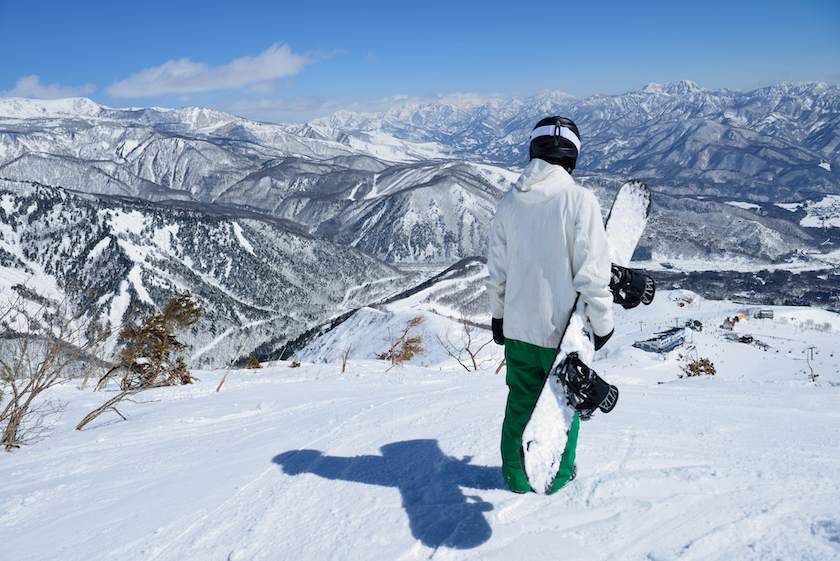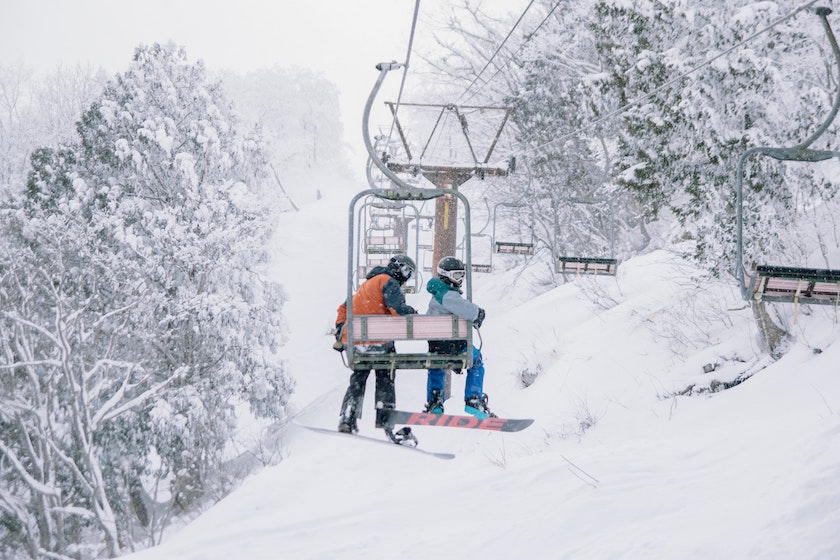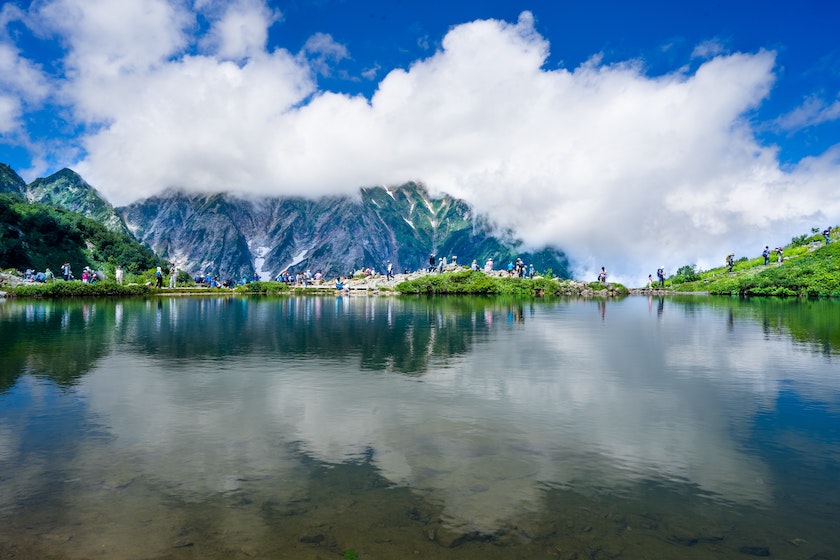Known as one of Japan’s premier alpine resorts, Hakuba offers winter skiing, snowboarding, and hot springs, with mountain trails, lakes, and more, in the summer.
Table of contents:

Intro
It’s hard to imagine that one of Japan’s best ski resorts is just three hours from Tokyo. Hakuba Valley in the Japanese Alps announced itself to the world as the main event site for the 1998 Winter Olympic Games in Nagano, but it has been famous within Japan for much longer. With its stunning mountainous peaks, white powder snow, ski slopes, and hot springs, Hakuba Valley is a genuine winter wonderland, making it a No.1 destination for snow sports enthusiasts, but it’s also a beautiful destination in spring, summer, and autumn. In these months, known as the green season, the landscape comes alive and is renowned for its hiking, flowers, and clearwater lakes - it’s perfect for nature lovers. In this guide we’ll tell you everything you need to know about Hakuba, including how to get there with your JR Pass, the best things to see and do, when to travel, and nearby attractions. Whether you’re visiting in winter or summer, Hakuba Valley offers some of Japan’s most spectacular scenery, adventure, relaxation, and excitement. 
History of Hakuba Valley
Hakuba Valley is used to describe a group of towns -Omachi, Hakuba, and Otari -at the base of the northern Japanese Alps. It is also not just one ski resort, but several - 10 to be exact - with more than 200 slopes. The largest resort is known as Happo-One and boasts a mountain beach with saunas and hot tubs as well as amazing ski slopes spread over 220 hectares. But there are many more to choose from, including Hakuba 47 and Hakuba Goryu, which are linked, Tsugaike Kogen, Iwatake, Yanaba, Cortina, Norikura, and Sun Alpina. It’s said that Tsugaike Kogen is the best slope for beginners and intermediates, while Iwatake is also good for families. Happo-One and Cortina are the more advanced and challenging runs. However, with 10 ski resorts there really is something for everyone and every ability level. Alongside winter sports, the resorts also offer the aforementioned hot springs and saunas as well as traditional Ryokan - Japanese inns for food and accommodation - hotels, restaurants, bars, annual music festivals, and more. Of course, most people come for the snow and with peaks as high as 3,000 metres, and an estimated snowfall of 11 metres each year, it’s easy to see why Hakuba is so popular for winter sports.
Hakuba village was founded in 1956 after the merger of two older villages, but the history of the region goes back thousands of years. More recently, the ownership of the land dates back hundreds of years to the Edo Period when it was part of Lord Matsumoto’s domain under the Tokugawa shogunate. At this time, Hakuba was part of the Shionomichi or ‘Salt Road’ - a route used to transport salt inland from the Sea of Japan. The domain was controlled from Matsumoto Castle, which remains one of Japan’s finest castles and can still be visited today. It is considered one of the country’s national treasures. For more information read our guide Visit Matsumoto: Castle City in the Japanese Alps.
Hakuba’s popularity as a skiing destination is a more contemporary development and first appears in the history books in the early 1900s, after the pastime was introduced to Japan. Mountaineers identified Hakuba as a good area for skiing and snow sports and by 1947, a type of Japanese accommodation known as Miinshikuku began to open to cater for the number of visitors. In the 1950s, ski lifts and resorts were built and Hakuba became increasingly famous as a winter destination. Skiing had a further worldwide boom in the 1980s when its popularity skyrocketed, and then in 1998, when the Winter Olympics were held in Nagano, Hakuba Valley and its numerous resorts officially arrived on the world stage. Today, thousands of ski and snowboard enthusiasts from around the world travel to Japan every year just to experience Hakuba - it’s that special.

Top 5 Things To Do in Hakuba
Hakuba is packed with things to see and do all year round, from skiing, snowboarding, and relaxing in a hot spring during the winter season to hiking, canoeing, and enjoying the beauty of nature in the summer months. Here’s our recommendation for the top five things to see and do while in Hakuba:
1.) Skiing and snowboarding
With more than 10 different ski resorts to choose from, there’s an incredible level of variety on offer across Hakuba Valley, from slopes that would challenge Olympic skiers to more gentle inclines that are perfect for beginners, holidaymakers, and families. Hakuba is especially known for deep powder and slopes that are typically steeper than elsewhere in Japan.
2.) Explore the three towns of the Hakuba Valley
While visiting the valley, make sure you explore Omachi, Otari and Hakuba for their own distinct attractions. Hakuba village is popular with visitors all year round as the home to five ski resorts and is also the starting point for climbers in the northern Alps. Omachi is part of the famous Tateyama Kurobe Alpine Route. With the peaks of Mt. Tateyama and Mt. Akazawadake – known as the Roof of Japan - and its famous snow corridor on one side, and the deep, forested valley of Kurobe Gorge with its sightseeing railway on the other, the Kurobe area in Toyama has two incredible adventures for the price of one. For more on this, read our guide to Exploring the Kurobe Alpine Route. Finally, Otari is the place to go for lovers of ‘Old Japan’ to step back in time, as it is a village which has kept the satoyama way of life.
3.) Relax in an onsen
As well as numerous onsen, hot springs, and mineral baths available at the many ski resorts for guests, Hakuba is also home to larger onsen towns like Yuzawa and Nozawa, specifically famed for their hot springs. Nozawa Onsen also boasts great slopes so you can combine excitement with relaxation. Be sure to check out the famous hot spring mineral baths known as Juro No-Yu at Kamishiro station too. They’re open 24 hours a day between December and March.
4.) Enjoy Hakuba’s ‘green season’
In the summer, many of Hakuba’s snow mountains and slopes, such as Hakuba Goryu in particular, become beautiful alpine gardens. As well as enjoying the scenery, the spring, summer, and autumn months offer walking, hiking trails, canoeing and other outdoor activities. Hakuba has many beautiful freshwater lakes and ponds (such as the famous Happo Pond) that come to life outside of winter and provide visitors with the chance to enjoy sport fishing, swimming, boating, and windsurfing. For climbing and hiking enthusiasts, our recommendation would be stunning Mount Shirouma, which can be hiked over two days. Read more in our Guide to Hiking in Japan. You can also enjoy ‘flower gazing’ in Hakuba’s beautiful alpine gardens. One such spot is Iwatake Lily Park in Hakuba - flowers are plentiful in the area and the park has been described as Japan’s garden of Eden.
5.) Find serenity at Chokoku-ji Temple
After the excitement of the slopes during winter, or the adventure of climbing and hiking in summer, why not take the time to find some inner peace at Chokoku-ji Temple, which is home to a number of treasures from the Heian Era, and where you can observe daily meditation and services for guests.
How To Get To Hakuba

You can get to Hakuba from Tokyo (via Nagano) in around three hours using your Japan Rail Pass and the JR Hokuriku Shinkansen. You’ll need to catch an express bus from Nagano for the last leg of the journey from Nagano to Hakuba, but this is very helpful, as it stops at the base of a number of popular ski resorts along the way. You can also travel to Hakuba from other destinations, including Matsumoto, if you want to include a visit to the famous castle. To do so, use the JR Oito Line. Finally, you can also use your JRailPass to travel to Hakuba from Nagoya. Both Kyoto and Osaka are accessible from Nagoya using the JR Tokaido Shinkansen. From Nagoya, you can also use the rapid Mie train to visit Ise and Toba in Mie Prefecture. Read our guide to the Rapid Mie Train for more information on this journey.
Skiing and Snowboarding in Japan
Japan is one of the world’s leading skiing and snowboarding destinations. Why is skiing in Japan so good? Well, it starts with the fact that Japan can receive as much as 15 metres (600 inches) of snowfall during winter. The snow that falls on Japan, caused by wind off Siberia crossing the Sea of Japan, is super light and leads to excellent skiing conditions. With regular snowfall that’s both deep and fine as powder, you’re in for a good time when you hit the slopes. The other great thing about travelling to Japan to ski is the length of the Japanese ski season. Stretching from December right through to early May, that’s a long window for you to plan your snow trip. For the best time to ski in Japan you want to come in January or the beginning of February for perfect conditions.
That said, spring skiing in Japan is still very good quality and better suited to those who want to spend time sightseeing in Japan as well. To find out more about winter sports in Japan, read our Starters Guide to Skiing and Snowboarding in Japan. This great guide has information about the best areas for winter sports including Nagano’s Hakuba Valley and alternatives such as Sapporo and Hokkaido as well as top tips for those new to ski resorts in Japan.
Meanwhile, for more information on when to visit Japan and the seasons, read our guide on Deciding When to Visit: Japan’s Seasons.
Bonus Tips
The Japanese Alps are an amazing destination whether you’re visiting in the winter season, or during the rest of the year. There are also some major attractions nearby that are a must-see for anyone visiting Japan’s Alps. Let’s take a look at our bonus tips:
- The Japanese Alps in Nagano Prefecture are also home to one of Japan’s most famous animal attractions - snow monkeys. And where better to see the Japanese Macaque than the famous Jigokudani Monkey Park in Nagano.
- If you’re planning on an outdoor adventure in Hakuba, whether it’s hiking the mountains or walking around the beautiful clearwater lakes, then it’s important to stay connected to the internet, and not just to upload Instagrammable photos to social media, but for directions too. That’s just one of the reasons PocketWifi, with its unlimited 24/7 internet, is so essential.
Remember, the best way to combine a visit to Hakuba with sightseeing across the rest of Japan is by ordering a JR Pass - the best value way to travel around the country using Japan’s world-leading domestic rail network.





